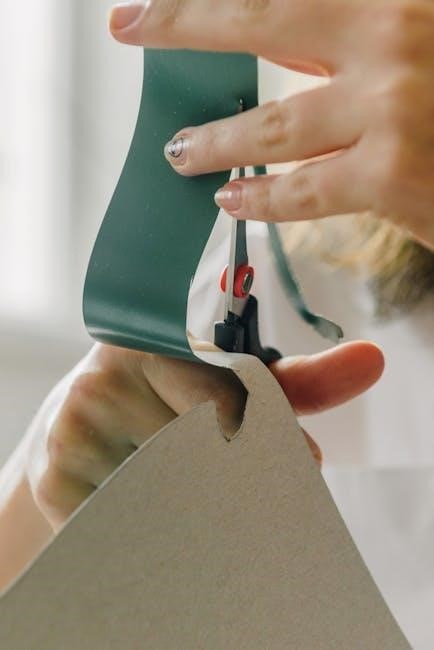Fision TV Guide is a comprehensive platform offering detailed channel listings‚ program descriptions‚ and advanced search options‚ designed to enhance your viewing experience with ease and convenience.
What is Fision TV Guide?
Fision TV Guide is a user-friendly platform designed to help viewers navigate and discover television content effortlessly. It provides detailed listings of channels‚ programs‚ and schedules‚ making it easy to plan your viewing experience. The guide includes advanced search options‚ program descriptions‚ and genre-based filtering‚ allowing users to find shows that match their interests. Additionally‚ it offers features like personalized watchlists‚ reminders for favorite shows‚ and parental controls to restrict content. Fision TV Guide aims to enhance the overall TV-watching experience by offering a comprehensive and intuitive interface for users to explore and enjoy their favorite programs. Its versatility and robust features make it a valuable tool for both casual and dedicated TV enthusiasts.
Benefits of Using Fision TV Guide
Using Fision TV Guide offers numerous advantages‚ enhancing your television experience through personalized recommendations and time-saving features. It allows users to discover new shows and movies tailored to their preferences‚ ensuring they never miss out on trending content. The guide’s advanced search and filtering options simplify the process of finding specific programs‚ saving valuable time. Additionally‚ Fision TV Guide supports multi-device compatibility‚ enabling seamless access across various platforms. Its user-friendly interface ensures ease of navigation‚ making it accessible to all audiences. Enhanced parental controls provide peace of mind for families‚ while customizable reminders keep viewers informed about upcoming episodes of their favorite shows. Regular updates ensure the guide stays current‚ offering the latest listings and features.

A Brief History of Fision TV Guide
Fision TV Guide was launched in the mid-2010s as a response to the growing demand for streamlined television and streaming content navigation. Initially designed as a simple schedule tool‚ it quickly evolved into a robust platform offering personalized recommendations and advanced features. The guide was developed to bridge the gap between traditional TV listings and the rising popularity of streaming services. Over the years‚ Fision TV Guide has expanded its capabilities‚ incorporating user feedback to enhance functionality and user experience. Today‚ it stands as a trusted resource for millions‚ continually updating to meet the ever-changing landscape of entertainment consumption. Its history reflects a commitment to innovation and adaptability‚ ensuring it remains a vital tool for viewers worldwide.

How to Use Fision TV Guide
Launch the app‚ browse channel listings‚ and explore shows by genre or popularity. Set preferences‚ filters‚ and reminders to personalize your viewing experience seamlessly.
Installation and Setup
Installing Fision TV Guide is straightforward. Download the app from the official store‚ launch it‚ and follow the on-screen instructions. Sign in with your account or create one if needed. The setup process includes selecting your preferred channels‚ enabling parental controls‚ and customizing your viewing preferences. Ensure your device meets the minimum requirements for smooth functionality. After setup‚ explore the interface to familiarize yourself with its features. The guide automatically updates channel listings and schedules‚ ensuring you always have the latest information. For optimal use‚ connect to a stable internet connection and sync with your smart devices if applicable. This seamless process ensures you’re ready to enjoy your personalized TV experience in no time.
Navigating the Interface
Navigating Fision TV Guide is intuitive and user-friendly. The home screen displays a sleek layout with categories like trending shows‚ new releases‚ and personalized recommendations. Use the search bar to quickly find specific programs or channels. The menu is accessible via a hamburger icon‚ offering options to browse genres‚ set reminders‚ and manage preferences. Channel listings are organized alphabetically or by popularity‚ with each entry showing airing times and brief descriptions. Hovering over a title reveals additional details without leaving the main view. The interface is responsive‚ adapting to various screen sizes and devices‚ ensuring a seamless experience whether on a smartphone‚ tablet‚ or smart TV. This design prioritizes accessibility and simplicity‚ making it easy for all users to find and enjoy their favorite content.
Setting Preferences and Filters
Setting preferences and filters on Fision TV Guide allows users to tailor their viewing experience. Customize channel listings by selecting favorite networks or hiding unused ones. Filter content by genres‚ such as drama‚ comedy‚ or sports‚ to narrow down options. Users can also set time slots to view schedules for specific hours or days. Parental controls enable restrictions based on ratings or maturity levels. Additionally‚ users can prioritize HD channels or sort listings alphabetically. These preferences sync across devices‚ ensuring consistency. Filters can be adjusted at any time‚ providing flexibility. By setting these options‚ users can streamline their browsing and focus on content that aligns with their interests‚ enhancing their overall entertainment experience with Fision TV Guide.

Features of Fision TV Guide
Fision TV Guide offers extensive channel listings‚ detailed program schedules‚ genre-specific filters‚ and advanced search options‚ ensuring users find their favorite shows effortlessly and efficiently.
Channel Listings and Schedules
Fision TV Guide provides a comprehensive list of channels‚ ensuring users can easily browse through their favorite networks. The platform offers detailed schedules‚ allowing viewers to plan their watching experience in advance. With real-time updates‚ users can stay informed about programming changes. The interface is user-friendly‚ making it simple to navigate through hundreds of channels; Advanced filters enable users to sort channels by genre‚ popularity‚ or personal preferences. Additionally‚ Fision TV Guide supports over 1‚000 channels‚ catering to diverse audiences. Whether it’s sports‚ movies‚ or documentaries‚ the guide ensures seamless access to live and upcoming shows. Users can also mark favorite channels for quick access‚ enhancing their overall viewing convenience.
Program Descriptions and Genres
Fision TV Guide offers detailed program descriptions‚ providing viewers with essential information about shows‚ movies‚ and events. Each listing includes plot summaries‚ genres‚ and ratings‚ helping users make informed decisions. The platform categorizes content into various genres‚ such as drama‚ comedy‚ action‚ and documentary‚ making it easier to find programs that match individual preferences. Users can explore trending genres or discover niche categories. Additionally‚ Fision TV Guide highlights recommended programs based on popularity and user ratings‚ ensuring a personalized experience. The robust filtering system allows users to sort content by genre‚ language‚ or age ratings‚ further enhancing accessibility and convenience for all audiences. This feature-rich approach ensures that users never miss out on their favorite shows or new discoveries.
Advanced Search and Filtering Options
Fision TV Guide features advanced search and filtering options‚ enabling users to quickly find specific programs or genres. The platform allows viewers to search by keywords‚ actors‚ directors‚ or titles‚ ensuring precise results. Multiple filters can be applied simultaneously‚ such as selecting by genre‚ language‚ or broadcast time‚ to narrow down choices. Users can also save their search preferences for future use‚ streamlining the process. Additionally‚ Fision TV Guide offers recommendations based on viewing history‚ enhancing the personalization of content discovery. These features make it easier for users to navigate through vast program listings efficiently‚ ensuring they never miss their favorite shows or new releases. The intuitive design ensures a seamless and user-friendly experience for all.

Customization Options
Fision TV Guide offers extensive customization options‚ allowing users to tailor their viewing experience by creating personalized watchlists‚ setting reminders‚ and applying filters to suit preferences.
Creating a Personalized Watchlist
Fision TV Guide empowers users to craft a personalized watchlist‚ ensuring they never miss their favorite shows or movies. This feature allows viewers to curate a tailored list of content that aligns with their preferences‚ making it easier to track and enjoy programming. By selecting specific channels‚ genres‚ or individual programs‚ users can build a unique lineup that reflects their interests. The watchlist is easily accessible across all devices‚ providing seamless convenience. Additionally‚ users can sort and prioritize their selections‚ ensuring their most anticipated shows are always at the forefront. This customization tool enhances the overall viewing experience‚ making it simple to stay updated on beloved series‚ new releases‚ and must-watch events.
Setting Reminders for Favorite Shows
Fision TV Guide offers a convenient reminder feature‚ ensuring users never miss their favorite programs. By setting reminders‚ viewers can receive notifications before a show airs‚ allowing them to plan their viewing schedule effortlessly. This feature is particularly useful for live events‚ season premieres‚ or special broadcasts. Reminders can be customized to alert users at specific intervals‚ providing ample time to prepare. Additionally‚ Fision TV Guide integrates seamlessly with calendar applications‚ syncing reminders across devices. This functionality ensures that users stay informed and up-to-date‚ making it easier to catch every episode of their beloved series or important programs. The reminder system enhances the overall user experience‚ offering peace of mind and convenience.
Parental Controls and Content Restrictions
Fision TV Guide provides robust parental controls‚ enabling users to restrict access to certain content based on ratings‚ genres‚ or specific channels. This feature ensures a safe viewing environment for children by blocking inappropriate material. Parents can set PIN-protected profiles‚ allowing them to customize restrictions for different family members. Additionally‚ time limits can be imposed to control screen time. The platform also offers a kid-friendly mode‚ filtering out mature content automatically. These controls are easily managed through the settings menu‚ providing peace of mind for parents while giving them flexibility to tailor restrictions according to their preferences. This feature is essential for families‚ ensuring a secure and enjoyable viewing experience for all ages.

Popular Shows and Movies
Fision TV Guide highlights trending shows‚ new releases‚ and popular movies‚ ensuring users stay updated on the latest entertainment options across various genres and platforms.
Trending Shows on Fision TV Guide
Fision TV Guide keeps users informed about the latest and most popular TV shows currently trending across various platforms. From critically acclaimed dramas to hilarious comedies and gripping reality TV‚ the guide provides real-time updates on shows that are captivating audiences worldwide. Users can easily discover what’s hot and trending‚ with detailed descriptions‚ genres‚ and viewer ratings. Fision TV Guide also offers personalized recommendations based on user preferences‚ making it easier to find new shows to enjoy. Additionally‚ the platform highlights popular episodes‚ season premieres‚ and exclusive content‚ ensuring viewers never miss out on the latest entertainment trends. This feature is a must-have for anyone looking to stay updated on the ever-changing world of television.
New Releases and Premieres
Fision TV Guide is your go-to source for staying updated on the latest new releases and premieres across various channels and streaming platforms. The guide provides real-time updates on upcoming episodes‚ season debuts‚ and exclusive content‚ ensuring you never miss out on the latest entertainment. With detailed listings and reminders‚ Fision TV Guide helps users track their favorite shows and discover new ones. Whether it’s a highly anticipated series premiere or a blockbuster movie release‚ Fision TV Guide keeps you informed with accurate and timely information. This feature is essential for anyone who wants to stay ahead of the curve and enjoy the freshest content available.
User Reviews and Ratings
Fision TV Guide incorporates a dynamic user reviews and ratings system‚ allowing viewers to share their opinions on shows‚ movies‚ and channels. This feature fosters a sense of community by enabling users to discover content based on collective preferences. The platform aggregates ratings from various sources‚ providing a comprehensive overview of popular and critically acclaimed programs. Users can also leave their own ratings and reviews‚ contributing to the platform’s growing database of audience feedback. This tool helps viewers make informed decisions about what to watch‚ while also highlighting emerging trends and audience favorites. By leveraging user-generated content‚ Fision TV Guide enhances the overall viewing experience and ensures that users can easily find shows that align with their tastes and preferences.

Technical Requirements
Fision TV Guide supports a range of devices‚ including smart TVs‚ streaming boxes‚ and mobile platforms‚ ensuring compatibility and smooth streaming across various hardware configurations and operating systems.
Supported Devices and Platforms
Fision TV Guide is compatible with a wide range of devices‚ ensuring accessibility for all users. It supports smart TVs from leading manufacturers like Samsung‚ LG‚ and Sony‚ as well as popular streaming devices such as Roku‚ Chromecast‚ and Amazon Fire TV. Additionally‚ the platform is available on mobile platforms‚ including iOS and Android‚ allowing users to access their favorite shows on-the-go. Fision TV Guide also works seamlessly with modern web browsers‚ making it easy to plan your viewing schedule from any computer or tablet. This cross-platform compatibility ensures that users can enjoy a consistent and high-quality experience regardless of their preferred device or operating system.
Video Quality and Streaming Options
Fision TV Guide offers exceptional video quality and flexible streaming options tailored to various internet speeds and user preferences. The platform supports high-definition (HD) and 4K Ultra HD streaming‚ providing crisp and vibrant visuals for an immersive viewing experience. Adaptive bitrate streaming ensures smooth playback even on slower connections‚ adjusting video quality dynamically to prevent buffering. Additionally‚ Fision TV Guide allows users to customize their streaming settings‚ choosing from options like 1080p‚ 720p‚ or lower resolutions based on their data usage and bandwidth availability. This ensures that viewers can enjoy their favorite shows and movies without interruptions‚ regardless of their internet speed or device capabilities.
Compatibility with Smart TVs and Streaming Devices
Fision TV Guide seamlessly integrates with a wide range of smart TVs and popular streaming devices‚ ensuring a smooth and accessible viewing experience across various platforms. The guide is compatible with leading brands such as Samsung‚ LG‚ Sony‚ and Vizio smart TVs‚ as well as streaming devices like Roku‚ Amazon Fire TV‚ Google Chromecast‚ and Apple TV. This broad compatibility allows users to access their favorite shows and movies from any connected device. Additionally‚ Fision TV Guide supports cross-device synchronization‚ enabling users to start watching on one device and resume on another without missing a moment. This versatility makes Fision TV Guide a convenient choice for modern households with multiple viewing options.

User Experience
Fision TV Guide delivers a seamless and intuitive experience‚ offering a user-friendly interface with enhanced accessibility features to ensure effortless navigation for all viewers‚ regardless of their tech expertise.
User Interface Design
The user interface of Fision TV Guide is thoughtfully crafted to provide an intuitive and visually appealing experience. With a clean‚ modern layout‚ the platform ensures easy navigation‚ allowing users to quickly find their favorite shows or discover new content. The design emphasizes clarity‚ with clear categorizations and prominent display of essential information such as channel listings‚ program descriptions‚ and scheduling details. Interactive elements‚ such as hover-over descriptions and clickable filters‚ enhance usability without overwhelming the user. The color scheme and typography are chosen to reduce eye strain and improve readability‚ making it accessible for extended use. Regular updates to the interface ensure it remains contemporary and aligned with user preferences‚ fostering a seamless and enjoyable viewing experience.
Accessibility Features
Fision TV Guide prioritizes inclusivity with robust accessibility features‚ ensuring all users can enjoy a seamless experience. The platform supports screen reader compatibility‚ enabling visually impaired users to navigate effortlessly. Keyboard navigation is fully functional‚ allowing individuals who prefer or require keyboard-only interaction to access all features. Closed captions are available for the majority of content‚ aiding hearing-impaired viewers. Additionally‚ customizable font sizes and high-contrast display options cater to users with visual impairments. Voice command integration further enhances accessibility‚ permitting hands-free control. These thoughtful features ensure Fision TV Guide is accessible to a diverse range of users‚ promoting equality and ease of use for everyone.
Multi-Device Support
Fision TV Guide offers seamless multi-device support‚ allowing users to access their favorite shows across various platforms. Whether on a Smart TV‚ tablet‚ smartphone‚ or streaming device‚ the experience remains consistent and intuitive. Syncing preferences and watchlists across devices ensures uninterrupted viewing‚ enabling users to pick up where they left off effortlessly. Enhanced responsiveness adapts the interface to different screen sizes‚ maintaining clarity and functionality. This versatility makes Fision TV Guide a convenient choice for viewers who enjoy watching content on multiple devices‚ ensuring they never miss out on their favorite programs regardless of where they are or which device they use.

Availability and Updates
Fision TV Guide is widely available for download on official app stores. Regular updates ensure improved functionality‚ new features‚ and bug fixes for enhanced user satisfaction.
Where to Download Fision TV Guide
Fision TV Guide is easily accessible for download on various platforms. Users can find it on the Apple App Store for iOS devices and the Google Play Store for Android devices. Additionally‚ it is available on the official Fision TV website‚ ensuring compatibility with multiple operating systems. The app is also supported on smart TVs and popular streaming devices like Roku and Amazon Fire TV. Regular updates are rolled out through these platforms‚ ensuring users have the latest features and improvements. Downloading is straightforward‚ with clear installation instructions provided on each platform. This wide availability makes Fision TV Guide a convenient choice for viewers looking to enhance their entertainment experience across different devices.
Regular Updates and New Features
Fision TV Guide is consistently updated to enhance user experience and add innovative features. Regular updates ensure the app stays current with the latest programming schedules and technological advancements. These updates often include new features such as improved search functionality‚ enhanced genre filtering‚ and personalized recommendations based on viewing habits. The development team prioritizes user feedback‚ incorporating suggestions to refine and expand the app’s capabilities. Updates are available for download on all supported platforms‚ including iOS‚ Android‚ and smart TV systems. Each update aims to improve performance‚ fix any issues‚ and introduce fresh tools to make TV watching more enjoyable. This commitment to continuous improvement ensures Fision TV Guide remains a cutting-edge solution for entertainment enthusiasts.

Fision TV Guide offers a comprehensive and user-friendly experience‚ making it an essential tool for viewers seeking convenience and personalized entertainment solutions.
Fision TV Guide offers a wide range of features designed to enhance your viewing experience. It provides comprehensive channel listings‚ detailed program descriptions‚ and advanced search options to help you find your favorite shows quickly. The platform also supports multi-device synchronization‚ allowing you to access your personalized watchlist and set reminders across all your devices. Additionally‚ Fision TV Guide includes parental controls to restrict content based on age-appropriate ratings. With its intuitive interface and robust customization options‚ Fision TV Guide ensures that you never miss your favorite programs while maintaining a seamless and enjoyable user experience. These features make it a versatile and essential tool for TV enthusiasts.
Future Outlook for Fision TV Guide
Fision TV Guide is poised for continued growth and innovation. With plans to integrate AI-driven recommendations and voice command functionality‚ the platform aims to further personalize the viewing experience. Enhanced multi-device synchronization and expanded parental controls are also on the horizon. Additionally‚ Fision TV Guide is exploring partnerships with leading streaming services to offer a unified entertainment hub. By focusing on user-centric updates and cutting-edge technology‚ Fision TV Guide is set to remain a leader in the TV guide industry‚ providing unparalleled convenience and satisfaction for audiences worldwide. Its commitment to innovation ensures it will adapt to evolving viewer preferences and stay ahead in the competitive landscape.

























